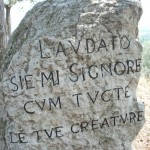When the Vatican Congregation of Rites revised the liturgical calendar in 1961, removing a whole list of saints from universal commemoration, it hit my little corner of the world pretty hard. There was the demotion of Mr Christopher, valued among us preteens not as the patron of motorways but because the giving of his St Christopher medal by a boy to a girl was the Catholic sixth-grade mark of Going Steady. (“He LIKES me likes me!”) St Vibiana, patroness of the Los Angeles cathedral, suddenly had no reason to be resting in waxen, relic-encased effigy in her Snow White glass casket under the altar. And Philomena! My poor Aunt Phil, saddled with the name but deprived of a name day. Our parochial school principal, Sister Philomena, suffered even worse: What authority could a nun with a no-saint name and a bad back command?
Of all these undocumented aliens of the altar, Philomena fell hardest. No one knew enough about Vibiana to care, and Christopher—with his vivid fairytale legenda and appeal to race-car drivers—has always had enough machismo to thumb his giant nose at Vatican congregations. (“Feast days? I don’ need no steenkin’ feast days!”) But Philomena had the distinction of being at one and the same time one of the most popular Catholic saints—popular, ironically, among a whole range of other Catholic saints—and a person about whom absolutely nothing is known. We don’t even know if she was a person at all.
On this her erstwhile feast day, a look at the Rise and Fall of Philomena is instructive.
The relics of the purported first century virgin martyr Philomena weren’t actually discovered until 1802, in the excavation of the catacombs of Priscilla. A few bones and what was later described as a vial of blood were found under some stones containing an inscription about light and faith and several symbols consistent with the iconography of virgin martyrs: three anchors, two arrows, a palm branch, and a flower. But no name.
Still, by the time a young priest arrived in Rome three years later, in hot pursuit of the remains of “a sainted martyr with a name” to bring attention to his oratory in the small town of Mugnano, Philomena had acquired both a name and the patronage of Pope Pius VII, who gave Philomena to the priest with all the sentimental blessings of a father of the bride. And the “marriage” was a fruitful one, in pilgrims’ terms. From the moment Philomena’s relics landed in Mugnano, the miracles began rolling in. So many cures, conversions, and reconciliations were effected by her intercession that it stopped being of any importance that no one knew who she had been. Various devotees have claimed over the years to have received versions of a biography via private revelation, but once the Sainted Martyr With a Name had delivered the future Pio Nonno from epilepsy, it no longer mattered. Pope Gregory XVI called her the Thaumaturge (Wonder-Worker) of the 19th Century, a title better than any paltry birthdate or martyrology. Pius X refuted vehemently any efforts to claim that Philomena’s name was just confusion with that of the other occupant of the catacombs where her relics were found, Priscilla.
Popes loved her, and they were joined in fervor by some of the era’s greatest saints. John Vianney, the Cure of Ars, called Philomena the True Light of the Church Militant. He built a basilica in her honor, where he installed the relic he had been given by the Venerable Pauline Jaricot, foundress of the Society for the Propagation of the Faith. (Innumerable “pagan babies” were given the name Philomena in honor of the foundress’s favorite saint, as I recall.) Father Damien dedicated the first leper chapel on Molokai in her honor. The American missionary saints John Neumann and Frances Cabrini spread devotion to Philomena throughout the Catholic United States. Padre Pio, himself no mean thaumaturge, once silenced critics of her cult by snarling, “For the love of God! It might well be that her name is not Philomena, but this Saint has performed many miracles and it is not the name that did them.”
Apparently you can take the girl out of the calendar, but you can’t take her out of our hearts. Devotion to St Philomena flourishes in shrines and archconfraternities around the world, some 60 years after she was stricken from the rolls. She’s still the Patroness of the Living Rosary and of the Children of Mary. And hers is such a quintessentially Catholic story (er, non-story) that I couldn’t resist retelling it. The takeaways?
You don’t need to be anybody special to be a saint. Sometimes you don’t even have to be anybody at all.
When surrounded by miracles, don’t sweat facts. You don’t want to piss off guys named Pio by being a stickler.
The kind of Catholic woman most likely to draw the respect and affection of popes may well be one who never committed the inconvenient sin of actually existing. LCWR, take heed.
With church attendance down, it might be time to send out young curates in search of Sainted Martyrs With Names to up the October counts. We try so many other stretategies . . . couldn’t hurt.
Happy name day, Aunt Phil, Sr Philomena, and all those unfortunate pagan babies. St Philomena, whoever you were or weren’t, pray for us!
___
For a similarly quirky look at the saint whose feast day we (still) celebrate tomorrow, see Max Lindenman’s terrific reflection on St Maria Goretti—from the point-of-view of her murderer.
And for my friends at the Patheos Pagan Channel, we don’t do that really strange buy-and-name-a-pagan-baby thing anymore. Honest. (Though I must say, to my friends at the Patheos Mormon Channel, that it left Catholics slightly more sympathetic toward that retro-baptism thing than we might have been otherwise.)











